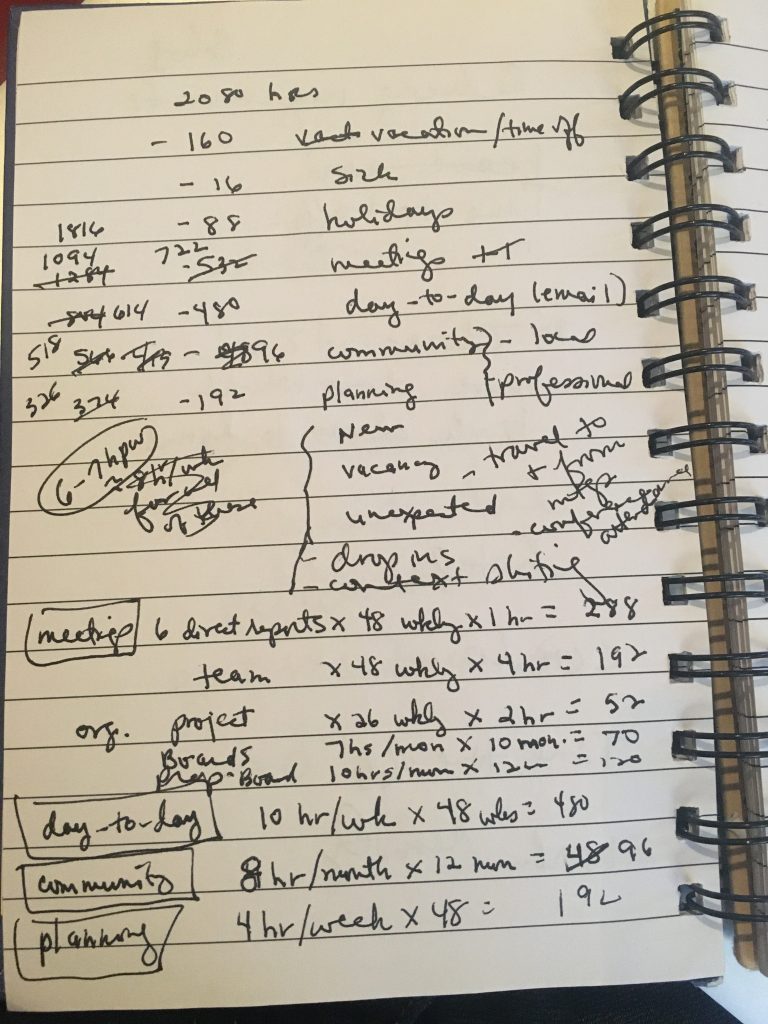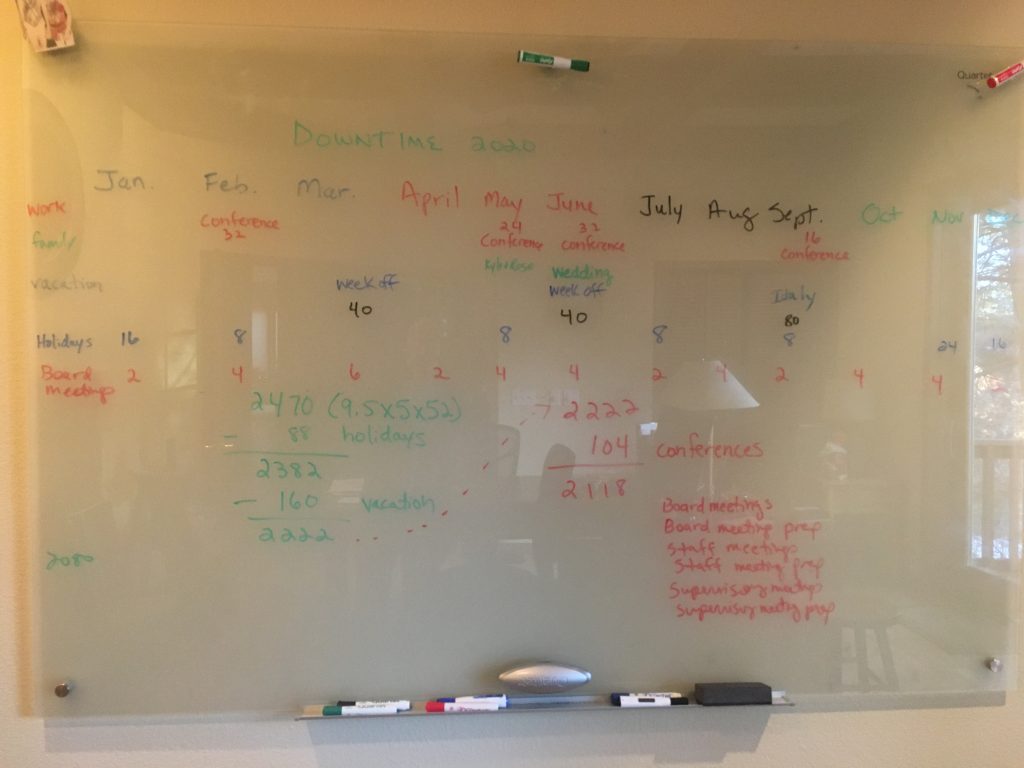By nature I’m a productive person. As a self-preservation Enneagram type 3, I optimize my time in all kinds of interesting ways. What this can mean is that when I don’t have an immediate task, I search for ways to be productive. It can be a challenge for me to just sit, even just sit and read. And I’m a librarian.
And I know how important downtime is for health and well-being. There are a million studies that show how the brain needs rest for creative problem-solving and productivity. Knowing this and actually making it happen are two very different things for someone like me.
Clock in My Head
I always have a clock running in my head. I also like to map things out to see how I’m spending my time. As the calendar moves to the New Year (new decade, we’re reminded), I’m motived to try something new and see if I can still manage my work and life if I also take off all my earned leave in a year.
Anyone who has been reading along knows I like to play with numbers. When I do these made-up exercises I usually discover an actionable idea I can put into practice. See Where Does the Time Go?; 168 Hours; 30 Minutes for 30 Days for examples.
I’ve come to the point in my career when I earn 4 weeks of paid time off (PTO) and have 11 holidays as well. I realize that my situation is one of privilege – I’m not new in my job or a single mom with two jobs or someone who needs that PTO to care for a sick family member. There are multiple levels to my reason for examining this issue: As the leader of my organization, I want to model the behavior of taking time off to recharge. As a human being, I know I need time off to be my best self at home and work. I want people taking their earned leave. And people need the boss to be gone sometimes.
2080 Hours?
So I took the 2080 hours a full time person is scheduled to work in a year – theoretically – and started to break it down. I subtracted 160 hours for vacation, 88 hours for holidays, and 16 for sick. Then I started subtracting time for regular meetings, day-to-day work, community outreach, and planning. That left me with 326 hours in the year which left about 6-7 hours per week to spare. That seemed pretty good. A colleague told me she scheduled 85% of her time for day-to-day, 15% for projects and 5% for the unexpected.
That made me realize I forgot to factor in things like having to cover when someone else is out sick or on vacation. Then I had to add in travel to and from offsite meetings, drop-in conversations, lunch. Dang. Oh yeah, then I realized I forgot to map in going to a conference or training. What if those require travel?
Just when I thought I’d accounted for every contingency, I realized that I would also need to plan for at least one top-level vacancy in a year and the time it takes to recruit, hire, orient, and train. And then there’s the unexpected situations that crop up and take more time that I should know by now to expect like scrambling when there’s a network outage, responding to legal issues, and putting out the occasional fire. Below is my math. I got stuck.

2480?
A CEO works more than 2080, so I decided to factor in a number closer to my reality. A Harvard study showed that CEO’s of complex, multi-billion dollar companies work about 9.7 hours per day and also put in about 4 hours on the weekend and 2.5 hours per day when on vacation. While I do often put in hours on the weekend and sometimes on vacation, the organization I lead isn’t a global multi-national company. My starting number would be closer to 2480 than 2080. This gives me a little more room to factor in shooting-the-breeze time not only with direct reports but all levels of staff, particularly customer-facing.
When I started with this higher number and subtracted holidays and vacation time, I showed 2222 hours of work ahead of me for the year. I decided that I wanted conference time to be part of my work hours rather than something extra that I had to make up for on evenings or weekends. Or at least try.
Then I listed out all the meetings I have scheduled, trying to be realistic about prep vs actual vs follow up. I was being ridiculous. I was aiming for a new way to approach my work and instead ended up down a rabbit hole of trying to account for every single hour of every single week over the course of a year. Sisyphean. I stopped here.

Optimizing through Outlook
Then a colleague at work told me she was trying out bullet journaling. As she described how it works, I realized I live by my Outlook calendar. What if I took some of the principles of bullet journaling and time management apps and applied them to how I operate naturally?
I had grown frustrated with my “to-do list” method and regularly ignore reminders and tasks I set for myself. But if I put something in my calendar, I do it. I sometimes blocked out “project time” on my calendar, but it was haphazard and didn’t often jive with the work on my to-do list. So I started something ridiculously simple. When a “to-do” arose, I made an appointment with myself on my calendar as “project time” to do this thing. The minute I took that step I realized, I had to calculate the amount of time I thought that task or project would take. As I practiced my new method I learned that often there were multiple critical path milestones connected that I wasn’t accounting for. What a reality check! My to-do list was a jumble of unrelated tasks as diverse as making a phone call to planning a meeting agenda. Now I was grouping like work, recognizing critical paths, and better accounting for actual time it would take to get a thing from to-do to done.
Ding!
For the past week when my phone or computer alerted me to an “appointment” on my calendar, I opened it up and started working on the projects listed. If I didn’t complete one, I had to find time on my calendar for that work. I couldn’t pretend it didn’t need to get done. I’ve only tried this for a week, but in that time I sure learned a lot about my habits. I hadn’t realized how often I put off some work, pretending it was no big deal for it to wait. Who knew a productive person could be such a procrastinator? I had a mental tic of saying to myself – oh, I can do that on Saturday. And I really, really don’t want to get into the habit of setting work appointments for myself on a Saturday.
Another aha for me was that by understanding my own habits better, I could be a better boss if I asked more questions of people who report to me about the time they were setting aside for project work, time off, and the unexpected. I know I’m not the only one on the team who approaches work and projects with a fair amount of denial about the real time cost.
My original intent in starting this exercise was to see how I and my team could take all our earned leave this year. I made pretty good progress. My time off for all of this year is actually put in my calendar. I’ve mapped out how I’ll spend that time off. I’m trying out a new technique for getting my work done. I’m starting to ask people when they are taking time off this year. And I’m taking a fresh look at our strategic plan to see that it not only propels us into the future but that it also allows us time – downtime – to put our toes in the sand.
Recommended Reading
How CEO’s Manage Time, by Michael E. Porter and Nitin Nohria.
I read this article when I started in my new role as executive director. I have a bit of an obsession with investigating how people who accomplish a lot spend their time.
Agile Project Management With Kanban by Eric Brechner, 2015.
I not only bought this book, I listened in on an online class to learn more about how this process works. I practiced it by myself for awhile and then brought it to the team to help us align our work. When an agile expert joined our team, we got better at it. There are fewer surprises and much more support for each other’s work.

March 1, 2020 at 2:46 pm
Thanks Donna for sharing your experiences with time management and it is highly beneficial to read it from the lens of your senior leadership role too. There is a pervading influence of workaholsim to success and so it makes it harder to stick to healthy time management habits. Thanks for sharing how you took an intentional step to put in your time off from work on your calendar and then made it a team activity urging your team members to do the same. Using Outlook calendar to reserve time for individual projects is a good suggestion. I’ve used it to remind me of things I need to do and expanding it to include work related projects can contribute to efficiency. Your article has motivated me to think of a group activity with the middle management team around swapping success stories related to time management. Thank you.
January 25, 2020 at 12:18 pm
testing comments